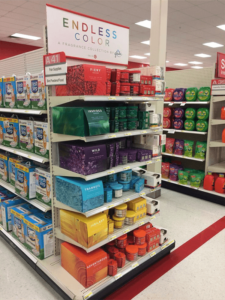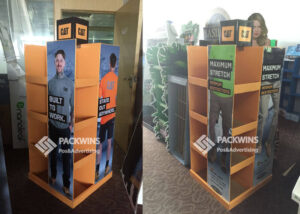In the competitive retail environment, catching a shopper’s attention at the point of purchase can make or break a sale. That’s where Retail POP (Point of Purchase) Displays come in. These versatile, custom-designed displays highlight products, enhance brand presence, and drive impulse buying.
In this complete guide, we’ll explain what POP displays are, how they support retail marketing, the most popular types, and how to select and manage them — including practical insights on packing, shipping, and manufacturing from China.
What Is a Retail POP Display?
A POP display, or Point of Purchase display, is a branded structure designed to promote products and encourage customers to buy right at the store. Unlike standard shelving, POP displays are temporary or semi-permanent marketing units used during promotions, launches, or seasonal campaigns.
While POS (Point of Sale) displays are usually found near the checkout counter, POP displays can be positioned anywhere on the retail floor — endcaps, aisles, or standalone areas.
According to Shop! Association, effective in-store displays can influence more than 70% of final purchase decisions — a clear reason why brand owners and retailers invest in POP innovation.
👉 Learn more: Custom Cardboard Displays
Why Retailers and Brands Rely on POP Displays
1. Driving In-Store Sales
Shoppers often make purchase decisions in seconds. According to NielsenIQ research, more than half of in-store purchases are impulse-driven. A well-positioned display captures that impulse with visual cues, brand messaging, and product accessibility.
2. Enhancing Brand Visibility
POP displays work as three-dimensional brand ambassadors. They communicate product benefits instantly through design, color, and structure. For brand managers, a strong in-store presence builds awareness and encourages trial.
👉 Related reading: Retail-Ready Packaging Solutions
Common Types of Retail POP Displays
POP displays come in many forms depending on your product, retail setting, and marketing goals. Here are the most popular types used by global retailers and club stores.
1. Floor Displays (FSDUs)
Freestanding floor displays offer large visual space for branding and can hold multiple product SKUs.
➡️ See our Free-Standing Display Units
2. Countertop Displays
Perfect for small products near checkout, these compact displays encourage impulse purchases.
➡️ Explore Counter Display Options
3. Pallet Displays
Used mainly in club stores like Costco and Sam’s Club, pallet displays combine high product volume with brand visibility.
➡️ Custom Pallet Displays
4. Endcap Displays
Located at the end of aisles, endcaps command high visibility and strong sales lift.
➡️ A Complete Guide to Using Endcap Displays
5. Dump Bins and Bin Towers
Ideal for promotional or clearance items, these open displays allow shoppers to easily browse and grab products.
➡️ Dump Bin Display Styles
6. Shelf Displays and Shelf-Ready Packaging (SRP)
These combine display and packaging functions, allowing products to go directly from shipping to shelf.
7. Hangsell or Hook Displays
Best suited for lightweight packaged products like accessories, snacks, or cosmetics.
How to Choose the Right POP Display for Your Product
Selecting the correct display type is essential for efficiency and ROI. Consider these key factors:
1. Match Display Type to Product and Retail Environment
Heavier items may need pallet or floor displays, while lighter or smaller goods perform better on hooks or counters.
2. Align with Campaign Duration and Budget
Temporary displays (4–8 weeks) are cost-effective for promotions. Semi-permanent ones (lasting months) justify a higher investment.
3. Choose the Right Material
Corrugated cardboard remains the most versatile and sustainable option for cost and flexibility. Other materials like acrylic or metal are used for longer campaigns.
Read more insights at Retail Dive.
Design Tips That Make POP Displays Stand Out
A visually strong display not only attracts attention but also simplifies decision-making for shoppers.
1. Use Eye-Catching Graphics and Colors
Ensure your display reflects your brand palette and communicates product value at a glance.
2. Keep Messaging Clear and Benefit-Focused
Short, bold statements outperform lengthy descriptions. Focus on “why buy now.”
3. Add Interactive or Digital Elements
QR codes, lighting, or touchpoints make displays more engaging — ideal for new product introductions.
For creative retail strategies, see Forbes Retail Marketing.
👉 Learn about Packwins’ Display Design Capabilities
The Custom vs. Standard POP Display Debate
When sourcing displays, brands often choose between customized and standard designs.
1. When to Choose Custom Design
Custom designs align perfectly with brand identity, product size, and marketing goals. Ideal for product launches or seasonal events.
2. Benefits of Standard POP Displays
For frequent promotions or limited budgets, standard templates reduce lead time and cost.
3. Balancing Cost and Branding Goals
Many brands use a hybrid model — customizing standard structures with unique graphics.
➡️ Custom Retail Display Manufacturing Services
Packing, Shipping, and Assembly of POP Displays
This is often the most overlooked part of a display project, yet it directly impacts total landed cost and retail execution success.
1. Flat-Pack Design Reduces Logistics Costs
Packwins engineers displays to ship flat-packed, significantly cutting shipping volume and freight costs — a major benefit for importers.
2. Protecting Displays During Transit
High-quality corrugate and reinforced edges prevent bending or damage during long-distance transport.
3. Easy Assembly for Retail Staff
Each display comes with step-by-step assembly instructions or QR-coded setup videos, saving time on the retail floor.
4. Global Shipping and Customs Solutions
Whether shipping DDP to the U.S. or consolidating in China, Packwins provides end-to-end logistics, ensuring displays arrive safely and on time.
👉 Learn about Packwins’ Logistics Support
Common Challenges in POP Display Projects (and How to Solve Them)
Even experienced procurement teams face challenges during retail display programs. Here’s how to manage them effectively:
1. Quality Consistency Between Samples and Mass Production
A reliable manufacturer should use the same materials, printing method, and die-line as your approved sample. Packwins enforces strict quality control protocols at every stage.
2. Managing Tight Retail Deadlines
Retail promotions are time-sensitive. A well-structured production schedule and real-time order tracking prevent costly delays.
3. Avoiding Shipping Damage or Cost Overruns
Choose a supplier experienced in international packaging standards. Optimizing carton dimensions and palletization helps reduce logistics costs.
Learn more from POPAI (Point of Purchase Advertising International)
Sustainability and Eco-Friendly Retail POP Displays
Today’s retailers and consumers demand sustainability — not just for ethical reasons, but because it strengthens brand reputation.
1. Use Recyclable and Biodegradable Materials
Corrugated cardboard, water-based inks, and recyclable coatings are now industry standards.
2. How Sustainability Builds Brand Trust
Eco-friendly displays demonstrate brand responsibility, which resonates strongly with modern shoppers.
👉 Explore Eco-Friendly Display Options
From Design to Delivery: The POP Display Production Process
Partnering with a manufacturer who manages the full process ensures speed, cost control, and consistency.
Step 1: Design Consultation and 3D Mockup
Clients share goals and product specs; Packwins provides a 3D render for visualization.
Step 2: Sampling and Prototyping
A physical sample confirms structure, fit, and print quality before mass production.
Step 3: Mass Production and Quality Assurance
Automated die-cutting, offset printing, and strict inspections guarantee high-quality output.
Step 4: Flat-Packing and Global Shipping
Displays are flat-packed for efficient shipping and delivered globally with full tracking.
➡️ See How We Bring Ideas to Life
Real-World Case Example: Boosting Sales Through Custom Pallet Displays
A global snack brand partnered with Packwins to design custom pallet displays for a nationwide supermarket campaign.
Challenge: The brand needed a high-volume display that shipped cost-effectively and assembled quickly in stores.
Solution: Packwins developed a flat-packed, corrugated pallet display that supported heavy product weight while maintaining vibrant print quality.
Result: The display achieved a 22% sales increase during the first promotion cycle.
👉 More Case Studies and Client Stories
Final Thoughts
A well-designed POP display is more than just packaging — it’s a sales tool that drives awareness, increases conversion, and creates a tangible link between brand and shopper.
For brand owners and retailers, choosing the right display partner can simplify everything — from design to logistics — while ensuring brand integrity at retail.
Packwins helps brands worldwide design, produce, and ship custom POP displays that are durable, cost-efficient, and eco-friendly.
👉 Contact Packwins today to discuss your next retail display project.



